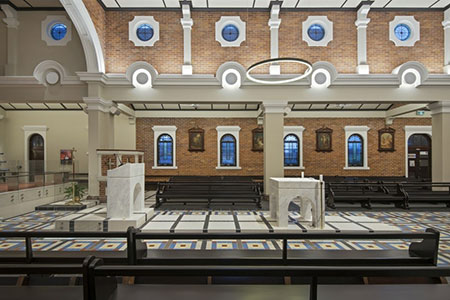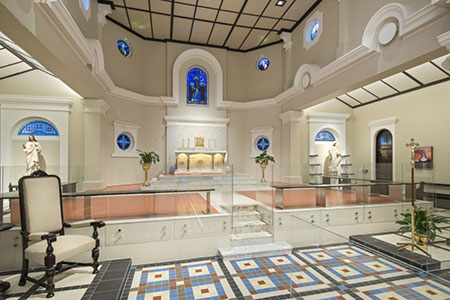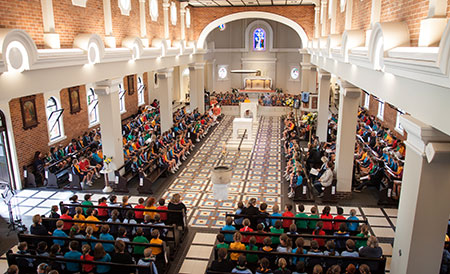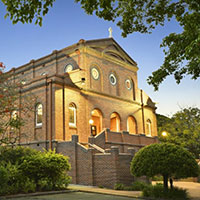In 1926 when the church was built, the question Who celebrates the liturgy? might have elicited the response Christ celebrates the liturgy, that is, the priest acting ‘in persona Christi’. Today, our response would be significantly different. We would respond Christ celebrates the liturgy, that is, the whole Body of Christ consisting of all the baptised. The full, conscious and active participation of all the faithful in the liturgical celebration is their right and duty by reason of their baptism (SC 14).

This shift in liturgical theology entails a changed approach to the architecture for liturgy. The altar, ambo and presider’s chair are no longer set in front of an auditorium but are located in the midst of a worshipping assembly. The balance of the assembly around the altar is crucial and has been achieved at Bulimba by placing the seating around the dignified central tiled area. The colours and lighting help refocus the space into the nave. The lighting is also important in giving to the church a sense of the sacred, for it is in the liturgical action that we touch a God who transforms us.

Since it is by baptism that each member of the faithful becomes part of the Body of Christ, the font is in the centre of the liturgical assembly, and it is from the font that people bless themselves as they arrive at the church. Our baptismal belonging, of course, is not just to the local community of the parish. Our font, a gift from the bishop of Worcester UK, is eight or nine hundred years old, a rich symbol of the Church of all times and places which celebrates the liturgy.

The altar, symbol of Christ, is carved from a single cube of Australian marble and is designed to hold together the double symbolism of the altar of the Lord’s sacrifice and the table of the Lord’s supper. In another wonderful link to the one, holy, catholic and apostolic Church, there is under the altar enshrined an authenticated relic of Saint Peter the Apostle, patron of the church (Ex Ossibus S. Petri Ap.). To represent the liturgical structure of word and sacrament, the ambo too is carved from a single block of marble in a design similar to the altar.

The original sanctuary has been carefully restored as a space for group prayer centred on the tabernacle which has been replaced on the first altar, now in its original location. The height of the sanctuary, the lighting, the seat around the edge and the clear glass balustrade subtly serve to mark off this area from the liturgical space in the nave.

The restoration has been a work of conservation: replacing the roof, repointing the external brickwork, repainting the interior, refurbishing the pews, conserving the Stations of the Cross and other devotional works, restoring the 140-year-old pipe organ. Within this historic framework, a strong contemporary statement has been made, creating a place to support and enhance the celebration of the liturgy.

This million-dollar project has been made possible by the extraordinary generosity of the people of the parish. With their pledges, the renovation is paid for. It is a worthwhile and very satisfying end to a demanding five-year parish project which began with education and discernment, continued with fundraising, and ended with design and construction. The church was dedicated on the solemn patronal feast of Saints Peter and Paul in 2016, the centenary year of the parish.
TOM ELICH, Parish Priest

